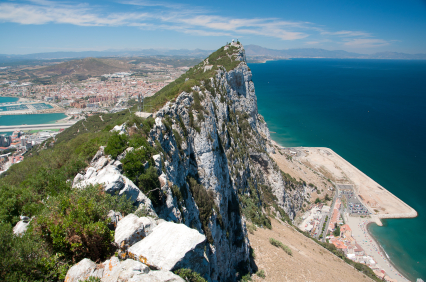Visitors to Gibraltar in pursuit of waving Union Jacks and the odd monkey will be satisfied. But those who linger after the tour busses leave will discover other attractions and cultures richly layered.
The Rock is often touted in the press – indeed it touts itself – as “home from home” and “the best of British in the sun”. It offers everything a Brit abroad could want: beer served in pints, real fish and chips and pub names like The Trafalgar and Nelson’s.
A climb to the top of the Rock will take you up a flight of steps painted garish with Union flags by the patriotic residents whose houses crowd round it.
And if you step out on September’s National Day the place is awash with more red, white and blue than Britain has seen since the last world war.
In this respect, Gibraltar is the perfect getaway for families seeking a spot of sunshine without the stress of wading through foreign menus with kids in tow. It is small enough not to lose the children, and its famous Barbary apes and old-English-style beaches are sufficient to keep them entertained.
But beyond all the more-British-than-the-British stuff is an exciting cultural melting point that many visitors pass by.
Colonial buildings bear the legacy of Maltese stonemasonry, Portuguese tiling and Neapolitan and Genoese jalousies – the hallmarks of a well-established population of immigrants who settled on the Rock on their way to the New World.
Shops in side streets sell necklaces of Moroccan dried figs piled up high next to coloured leather slippers and heavily embroidered kaftan shirts.
And behind Main Street, lunchtime fills the air with the delicious scent of boiling couscous and simmering tagines – whilst the streets fill with men in jalabas hurrying home to eat them.
Then on Saturday morning, the main drag fills with the exuberant orthodox Jewish community celebrating the Sabbath in a curious melange of English, Yiddish and Spanish.
It is an invigorating mix with plenty to hold tourists’ attention after they have had their fill of the Rock’s famous monkeys.
Visitors with an interest in history can enjoy the maze of military tunnels: it seems the saying “as solid as the Rock of Gibraltar” is misplaced, for in reality the limestone boulder is riddled with more than 43 miles of man-made passageways.
Some of these are still in use by the MOD and others are only accessible from below sea-level, but a fair few have been converted into a tourist attraction.
The siege tunnels as they are known take visitors back through Gibraltar’s military history, with costumed scenes depicting life around the Battle of Trafalgar in 1805.
They also offer incredible lookout points from inside the Rock and across to Spain.
For even more spectacular views, visitors should head up to Jews’ Gate where a statue pays homage to Hercules – the Greek god who marked Gibraltar as one of the pillars denoting the end of the world and the beginning of ne plus ultra.
From here, it is easy to see across the bay to the docks of the Spanish port of Algeciras, as well as to mighty Atlas Mountains in Morocco. It is hard to believe that Africa can be so close by but on a clear day you can see the white-washed houses of Tangiers, just begging for an easy ferry hop across.
Or you may prefer to head into the Strait with a dolphin safari, where boat operators offer a repeat-trip guarantee of the sight of at least one friendly fishy mammal. They usually come to play in the pressure wave formed at the bow of the boat and can be great fun to watch from one of the glass-bottomed vessels.
Gibraltar is also one of the world’s top sites for wreck diving. Scuba enthusiasts can investigate any number of war-ravaged ships and barges playing home to sea-life at the bottom of the Med. And for beginners, there is an artificial reef where waters protected from fishing throng with octopuses, starfish and other marine life.
But come the evening, its time to relax at one of the Rock’s excellent restaurants with outdoor dining at Marina Bay or upmarket Queen’s Way Quay. The usual range of cuisine is available, but visitors looking to sample the real flavours of Gibraltar should head to La Boheme in Irish Town for delicious Moroccan fare, or El Patio in Casemates Square for traditional Hispanic dining.
The square is also the spot for tax-free after-dinner drinks, when a lively crowd spills from rows of 19th century army barracks converted into bars.
It is also the perfect spot to sit back and soak up the atmosphere in a place that is a great deal more than just little Britain abroad.

Leave a Reply